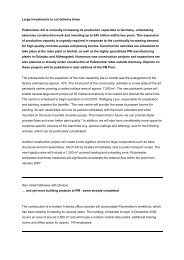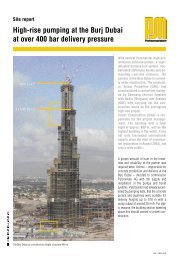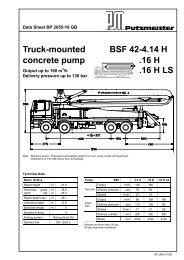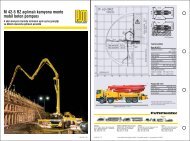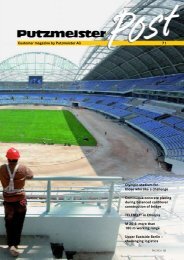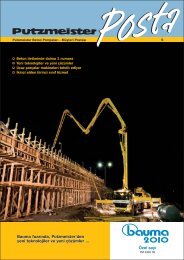2005 - Putzmeister
2005 - Putzmeister
2005 - Putzmeister
Create successful ePaper yourself
Turn your PDF publications into a flip-book with our unique Google optimized e-Paper software.
Special concrete<br />
The ZX delivery line in the lattice tower of the<br />
crane runs to the sliding formwork<br />
New platinum mine<br />
in South Africa:<br />
concrete placement on<br />
109 m high pit frame<br />
58<br />
60<br />
Platinum and its costly mining<br />
Platinum is currently almost twice as expensive<br />
as gold, and significantly harder.<br />
World-wide, only approximately 200 tons<br />
of this precious metal are mined each year,<br />
with 90 % of the production stemming<br />
from South African mines. Platinum is<br />
required, for example, for the production<br />
of catalytic converters in the automotive<br />
industry, in dental medicine, in space travel<br />
and for the production of jewellery. To<br />
acquire 15 grams of pure platinum, up to<br />
five tons of stone must be exploded, conveyed,<br />
pulverised and chemically treated.<br />
The metal is prepared above ground in<br />
high security areas. The platinum discovery<br />
sites around the Rustenburg region<br />
were mined in a strip of approximately<br />
400 km. Here, 27,000 miners work under<br />
the hardest of conditions at depths of<br />
approximately 2,000 m. With an air humidity<br />
of 90 %, there are temperatures at this<br />
depth of up to 50 °C. The platinum reserves<br />
were discovered in 1924 by the German<br />
geologist Hans Merensky. The land rights<br />
in Rustenburg belong to the Bafokeng<br />
clan, to which the IMPALA PLATINUM<br />
group assigns 5 % of its profit each year<br />
as payment for rights of use.<br />
In Rustenburg in South Africa, the<br />
IMPALA PLATINUM LTD mining company<br />
is investing significant sums of<br />
money in the mining of the precious metal<br />
platinum. In the meantime, work is being<br />
carried out on the completion of the 16th<br />
shaft. Already before commissioning,<br />
<strong>Putzmeister</strong> pumps were used here,<br />
although not for pumping residues from<br />
the ore dressing (tailings), but for highrise<br />
concrete pumping.<br />
In addition to constructing the shaft and<br />
connecting a new mining field to the existing<br />
mining fields, the tapping of a new<br />
mine also includes the installation of a pit<br />
frame. At its tip, the pit rope, to which the<br />
haulage skips for bringing up the mined<br />
material and the baskets for transporting<br />
the miners are attached, runs over a large<br />
pulley. In order to move the largest loads<br />
possible, or to achieve short circulation<br />
times, the pit frame must be of a certain<br />
height. At the 16th pit of IMPALA in<br />
Rustenburg, the tower is certainly not too<br />
small: with a base of 21 m x 20 m and a<br />
pulley at the record height of 109 m, the<br />
new pit is designed for extraordinary conveying<br />
capacities.<br />
A sliding formwork adapts to different<br />
wall thicknesses<br />
The work on the pit frame with several<br />
integrated concrete decks began with the<br />
pit brow at a depth of approximately 25 m.<br />
The main contractor assigned with the<br />
construction work is RENNIKS CON-<br />
STRUCTION. The project, costing around<br />
80 million rand (approximately EUR 10<br />
million), also includes the construction of<br />
the main ventilation shaft, several access<br />
tunnels, the foundation of the conveying<br />
system and various digging works.<br />
Completion is planned for May 2006.<br />
The walls of the pit frame, which are<br />
between 0.95 m and 0.55 m thick, were<br />
constructed using the sliding formwork<br />
procedure. Here, the formwork adapted<br />
22<br />
PM 3723 GB<br />
Truck mixers load the BSA 1408 E with a special type of concrete<br />
59<br />
In total, approximately 21,000 m 3 of concrete are processed<br />
at the pit frame<br />
62<br />
The PM gate valves are activated via a hydraulic circuit<br />
in the stationary pump<br />
61<br />
flexibly to the wall diameter which becomes<br />
thinner as you move upwards. The contract<br />
for concrete delivery was awarded to the<br />
specialists from MURRAY & ROBERTS<br />
CONSTRUCTION, who, incidentally, have<br />
been working with <strong>Putzmeister</strong> pumps for<br />
many years.<br />
In total, 7,000 m 3 of concrete was required<br />
to construct the carcass of the pit frame.<br />
The concrete used had a specially developed<br />
mixture breakdown. It contained,<br />
amongst other things, aggregate with a<br />
maximum particle size of 19 mm (of which<br />
50 % was slag), drift sand, stone dust and<br />
various concrete additives. The further<br />
details of the concrete composition are<br />
considered to be confidential. In other construction<br />
measures within the project, a<br />
further 14,000 m 3 of concrete was placed.<br />
The "chief operator" has full control of his <strong>Putzmeister</strong><br />
stationary pump. On the left you can see the cable<br />
remote control of the BSA 1408 E<br />
63<br />
BSA and rotary distributors<br />
work as a team<br />
The free-pumping material was delivered<br />
by MURRAY & ROBERTS with a<br />
<strong>Putzmeister</strong> BSA 1408 E via a ZX high<br />
pressure line, which was mounted on a<br />
tower crane. With a hydraulically activated<br />
gate valve, the concrete flow in the pipeline<br />
could be interrupted, for example for cleaning<br />
operations on the stationary pump.<br />
A second BSA was kept ready as a standby<br />
pump. The crane was set up about three<br />
metres from the carcass and mounted with<br />
cross-beams in the continuously rising<br />
structure. The upper end of the riser was<br />
connected with a flexible hose (DN 125),<br />
so that a connection to the RV 10 rotary<br />
distributor on the sliding formwork could<br />
be established at any time in the 90 ° delivery<br />
line bend. Incidentally, this too was a<br />
device manufactured by the <strong>Putzmeister</strong><br />
subsidiary in South Africa. In the interest<br />
of the most unrestricted slewing circle<br />
possible, the construction company elevated<br />
the four support legs of the deck distributor<br />
by approximately 5 m.<br />
Service technicians available at all times<br />
During the carcass construction phase,<br />
employees of <strong>Putzmeister</strong> South Africa<br />
were on site at least once a week. They<br />
trained the concrete pump operators, gave<br />
tips on cleaning and maintenance of the<br />
BSA and clarified any service questions.<br />
In addition, the PMSA emergency service<br />
was also available 24/7 via a hotline.<br />
A service technician could have been on<br />
site within 2 hours, if required.<br />
As the construction progressed, additional<br />
pipe sections were used between the riser<br />
and the delivery hose. On average, the pit<br />
frame grew by 4.5 m each day, with the<br />
best daily performance being 6 m. At<br />
109 m, the BSA 1408-E reached its highest<br />
pump height on the new IMPALA pit.<br />
23<br />
PM 3723 GB



![Data sheet BSA 1005 D SV (TB 2206) [.pdf; 459.58 kb] - Putzmeister](https://img.yumpu.com/51174022/1/184x260/data-sheet-bsa-1005-d-sv-tb-2206-pdf-45958-kb-putzmeister.jpg?quality=85)
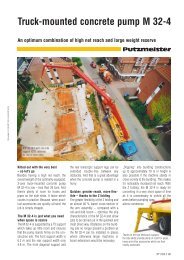
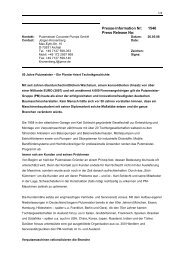
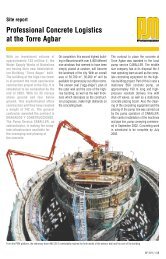
![Typenblatt CS 3095 [.pdf; 202.40 kb] - Putzmeister](https://img.yumpu.com/50530164/1/184x260/typenblatt-cs-3095-pdf-20240-kb-putzmeister.jpg?quality=85)
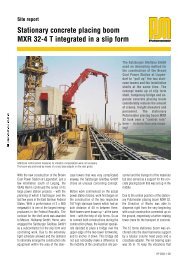
![M 47 Broşürü [.pdf; 527.92 kb] - Putzmeister](https://img.yumpu.com/49631771/1/190x141/m-47-brosuru-pdf-52792-kb-putzmeister.jpg?quality=85)

